Dear readers, this is the last part of my Kioke Summit report. Check out part 1, part 2, and part 3, if you have missed them.
Maybe because it was the second day of the Summit, but yesterday's frantic excitement was replaced by a mellow mood as everybody looked more relaxed, basking under the sun and enjoying the friendly atmosphere.
During the early-morning briefing, Yamamoto-san reminded us that one of the members of the kioke community, the Tanigawa Brewery, was among the victims of the recent earthquake in Noto. Yamamoto said that because of the disaster, that shoyu maker had to stop building his own wooden barrel, and then went around taking donations to help him get back on his feet. (After the event, I got an email stating that they were able to collect 532,794 yen).
Like yesterday, several activities went on at the same time, including barrel-making, taga core wrapping, and even making taga bracelets by weaving colorful strips of paper. Absolute beginners like me also had a chance to try their hand at barrel-making.
For me, however, the highlight of the day – and possibly of the whole Summit – was Yamamoto-san’s guided tour of the warehouse – the same place that had so much impressed Alice a few years ago.
When we entered, we found ourselves surrounded by giant kioke. Yamamoto saw our puzzled looks and explained that at first glance they may look rotten, but it was just because the wood is porous, allowing the microorganisms to attach themselves to the surface of the barrel. They actually live and thrive there, and after 100-150 years they thoroughly coat the surface. It's these microorganisms that make the taste and aroma of kioke shoyu so unique, and because it is matured in wooden barrels, each brewery is different.
To make us understand what he meant, Yamamoto compared a 150-year-old kioke with one “only” 100 years old. We could clearly see that the latter one had less mold on it, while the newest of the lot, made by Yamamoto himself ten years ago, was almost mold-free. “That’s why wooden barrels are irreplaceable,” he said. “I want to brew tasty, top-quality shoyu. Industrial-made shoyu leads to uniformity of taste and color. Aging it in wooden barrels is what gives it its depth of flavor. The difference is quite obvious when you taste it.”
While Yamamoto likes to say that the microorganisms do all the work inside the barrels, producing exceptional products requires a lot of hard work. For them to thrive, one needs to optimize the process, which involves a lot of duties, big and small, like regular manual stirring. Considering the vast size of the barrels, I could only imagine the difficulty of those tasks. “I manage to lose up to 10 kilograms in two months,” Yamamoto said.
The Kioke Craftsmen Revival Project originated from the necessity and desire to preserve the long tradition of wooden barrel-making. “This way, shoyu makers can learn how to make them themselves and do maintenance on the old ones they already have,” Yamamoto said. “I could have been just happy with making my own barrels, but I realized that if only my shoyu sold, the kioke shoyu industry would eventually disappear. Even now, the market for barrel-aged shoyu is a tiny 1%, and even if our shoyu sells, there are no jobs for barrel makers.”
On the other hand, if Yamamoto and his friends can make their dream come true, this will create a win-win relationship for manufacturers, barrel makers, and consumers. “My new goal,” Yamamoto said, 2is to increase Japan's consumption of kioke shoyu from 1% to 2%, and at the same time capture 1% of the world market. Call me a romantic, but my focus is not on the present. We need to be proactive for the sake of the future generations. The outcome will be seen after I'm gone.”
At lunchtime, Maejima Tsukasa from Ramen Setagaya (Tokyo) was in the improvised kitchen to make ramen, while Rice Is Comedy returned for another bout of egg on rice. I had a chance to talk to group member Shimizu Hiroyuki who explained that when not touring around Japan in his van he built houses. The other members were his old junior high school friends.
“When I left my hometown in Shiga, it had 4,000 inhabitants,” Shimizu said, “and by the time I came back to take over my family business, it had shrunk to 3,500 and had lost its vitality. Everybody was complaining and had a pessimistic view of the future.”
Shimizu’s story is not unique. Indeed, many small towns and country villages around Japan are at risk of disappearing as the young leave for the big cities and only old people are left behind.
“My friends and I wanted to cheer our people up, so we held various events that attracted many visitors. What we were trying to do was turn the negatives into positives, and when we looked for problems rooted in the area, we realized that everyone thought that our rice had no value. That was the trigger for us. We wanted to revitalize our town and decided to use rice as a weapon to regain our pride.”
Shimizu and his gang resorted to crowdfunding to buy a van, and several local businesses were only too happy to sponsor their activity. Eventually, they became a national hit and currently are receiving offers from some 40 locations across the country to appear in local events like the Kioke Summit.
“We look weird and crazy but we sincerely want to help those people, albeit in a funny way,” Shimizu said. “You could say we are seriously funny.”
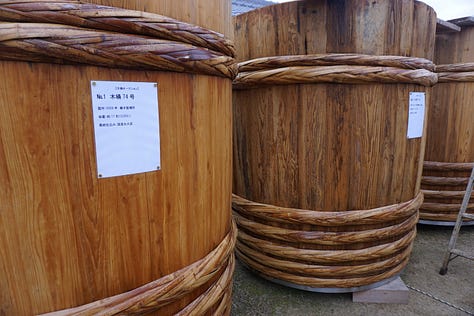
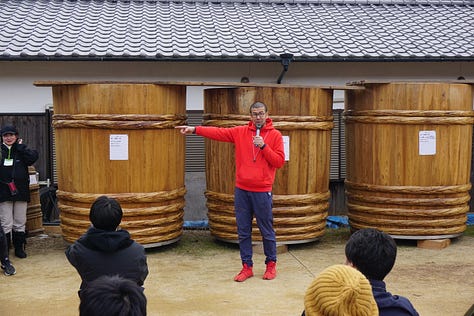
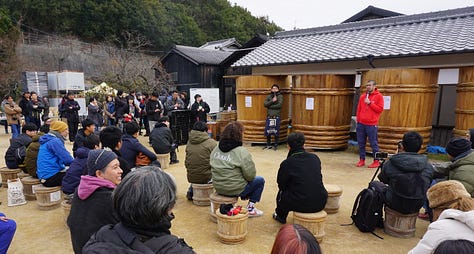
The afternoon program started with an auction: several bidders battled to get their hands on four barrels, led by the booming voice of improvised auctioneer Ito Daisuke, a veteran carpenter from Fukushima Prefecture and member of the Kioke Revival Project.
The last two barrels were purchased by a brewer from Hokkaido. The last one, in particular, was sold after a long and exciting battle between the man from Hokkaido - who was receiving instructions from his boss through a video call - and a local brewer. In the end, the man from Shodoshima raised his hands in defeat when the price reached an action-high 450,000 yen.
After the auction, while the other participants were still busy wrapping shin cores and taking part in other activities, I talked to Julien Clot, the shoyu brewer from Quebec, Canada, and his wife Vivian. This year was the second time for Julien to visit Shodoshima. Five years ago, he heard about Yamaroku and the Summit. The tightly-knit community created by Yamamoto reminded him of what he was doing in Quebec and decided that one day he would come and see how they made shoyu here.
Julien has a small company with two more employees plus two or three more people who are on call when things get busier. Julien’s original gluten-free shoyu is very different from what is sold in Japan: he uses neither soy nor wheat because an increasing number of people in North America have allergies. He also makes tempeh, kimchi, and other fermented products. “It’s a sort of fusion style, and we have a creative approach to the fermentation process,” he said. “Last year was my first time here. I sought Yamamoto-san's advice, brewed some shoyu with him, and changed my brewing approach a bit. I love the way they share their knowledge here. For me, learning from a master brewer was a real honor. Until now I haven’t used wooden barrels, but when I go home I'm going to get my very first one from a barrel maker in Quebec. It's a 400-liter barrel. I'm really excited and I can't wait to get started.”
Julien said that he was the only one to make shoyu in Quebec and there is only another company in Canada but it mostly deals in Japanese imports. On the other hand, the market for shoyu and other fermented products in Canada and the US is steadily growing. “More and more people understand their health benefits and are interested in gastronomic diversity,” he said. “We do niche stuff and don’t do any marketing, yet our customer base is growing every day. What we do seems to resonate with people.”
Vivian added that when they went home, they would take part in a big fermentation festival in Montreal in September. “Thousands of people attend every year,” she said. “Last year we did a presentation in which we also talked about this festival in Shodoshima, and when people tasted kioke shoyu they were so surprised and excited because some of those barrels are 100 years old. They value tradition and have a lot of respect for what brewers are doing. In the end, lots of people wanted to try shoyu and after tasting it they all wanted to buy it.”
This year’s Summit ended with the traditional Campfire Talk in which all the gathered brewers and other related people shared their feelings about the kioke community and talked about their current and future challenges. A brewer from Okayama, for instance, said that he had been attending for quite some time and was pleased to see many new people, especially young brewers who he believed would ensure kioke shoyu’s bright future.
I also talked to Kuroshima Keiko, the shoyu sommelier I had interviewed two years ago. “In Japan we take shoyu for granted,” she said, “but it really is a vital part of our daily lives. Japanese shoyu has a unique place in the world. Think about its color, taste, and flavor. There are few fermented seasonings anywhere that have such a nice aroma. There are also so many different types. One may be like mushrooms, another one like prunes. These differences become even more obvious when you warm it up. That’s because shoyu varies so much depending on the bacteria and the environment in which it ages.
At the end of the second day, we headed again to yesterday’s hotel for a farewell party. Throughout the event, each activity and speech were an opportunity to shout the event slogan. So it was natural to end this year’s Kioke Summit crying out loud once again, “Yattaru de! Okke!”
When I arrived two days ago, I didn’t know what to expect. I found a group of warm-hearted, cheerful people who are deeply committed to their mission and never lose sight of the strong human bond that unites them.
I also discovered Shodoshima, an island that, apart from shoyu, deserves to be added to the to-do list of anybody interested in Japan. I hope to be back soon.

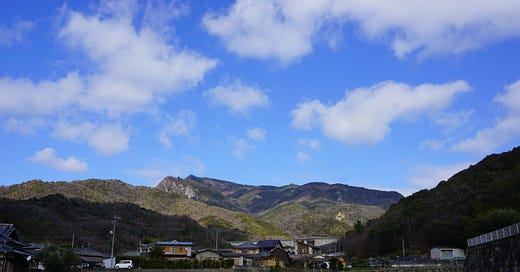



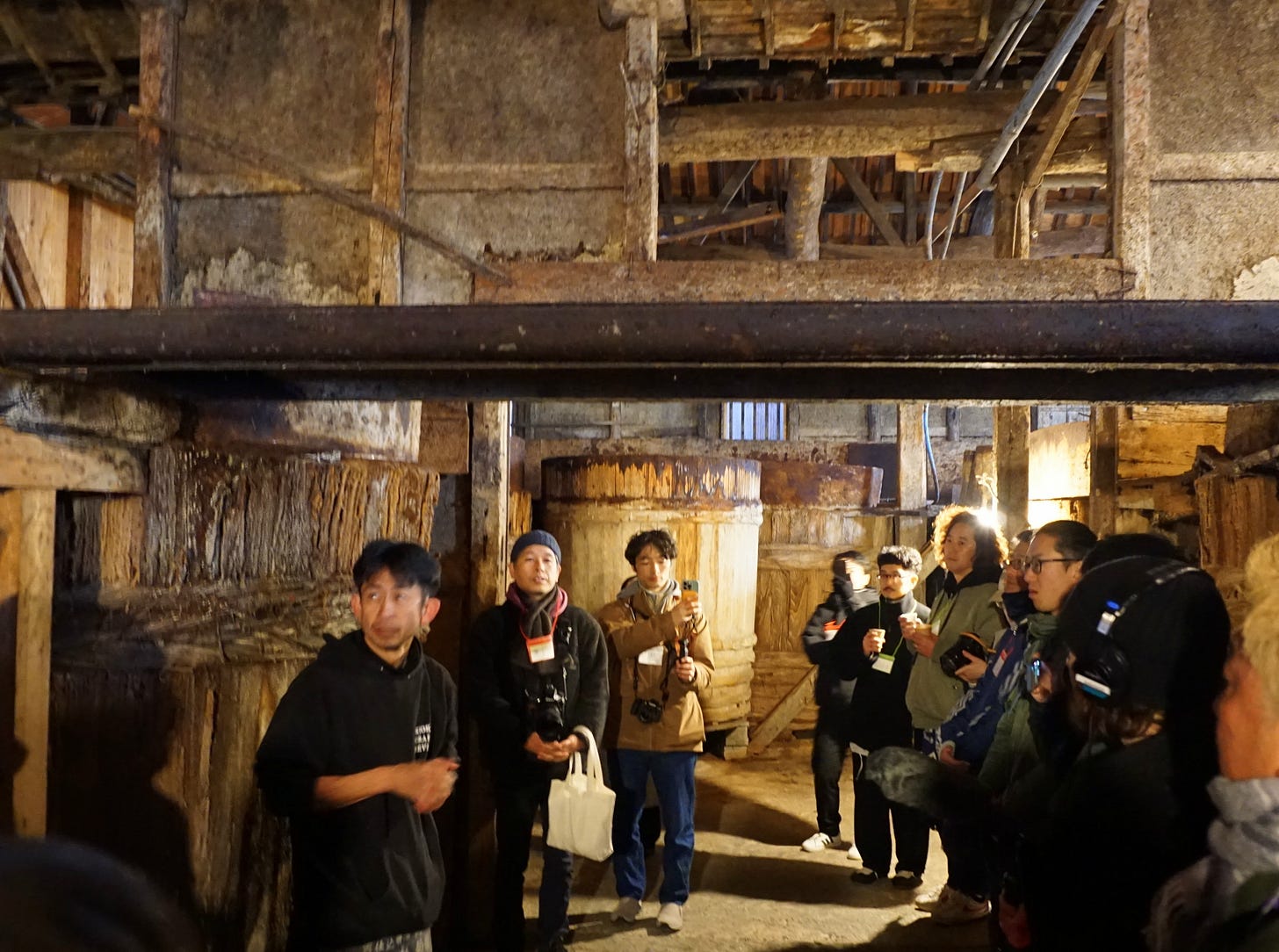

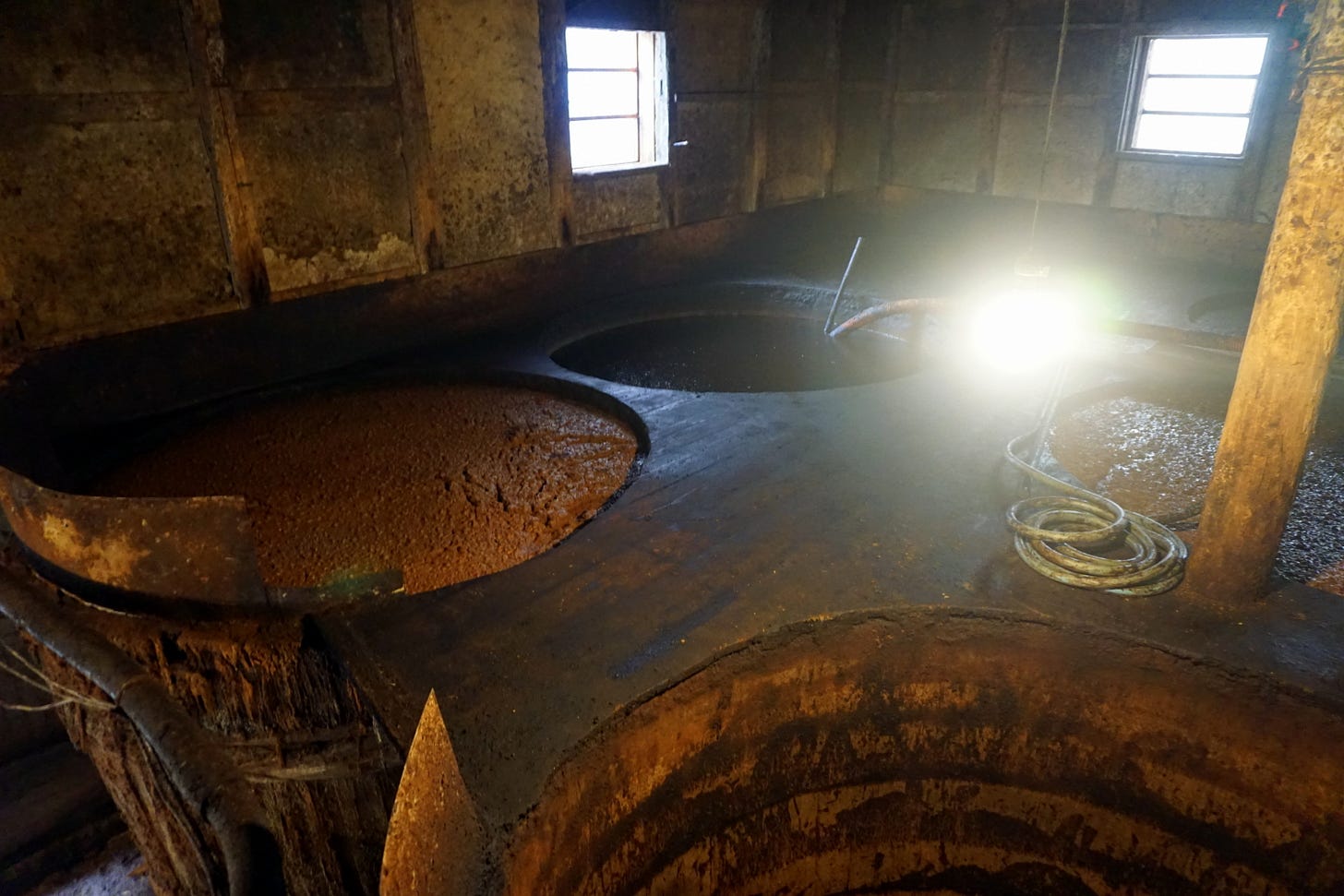


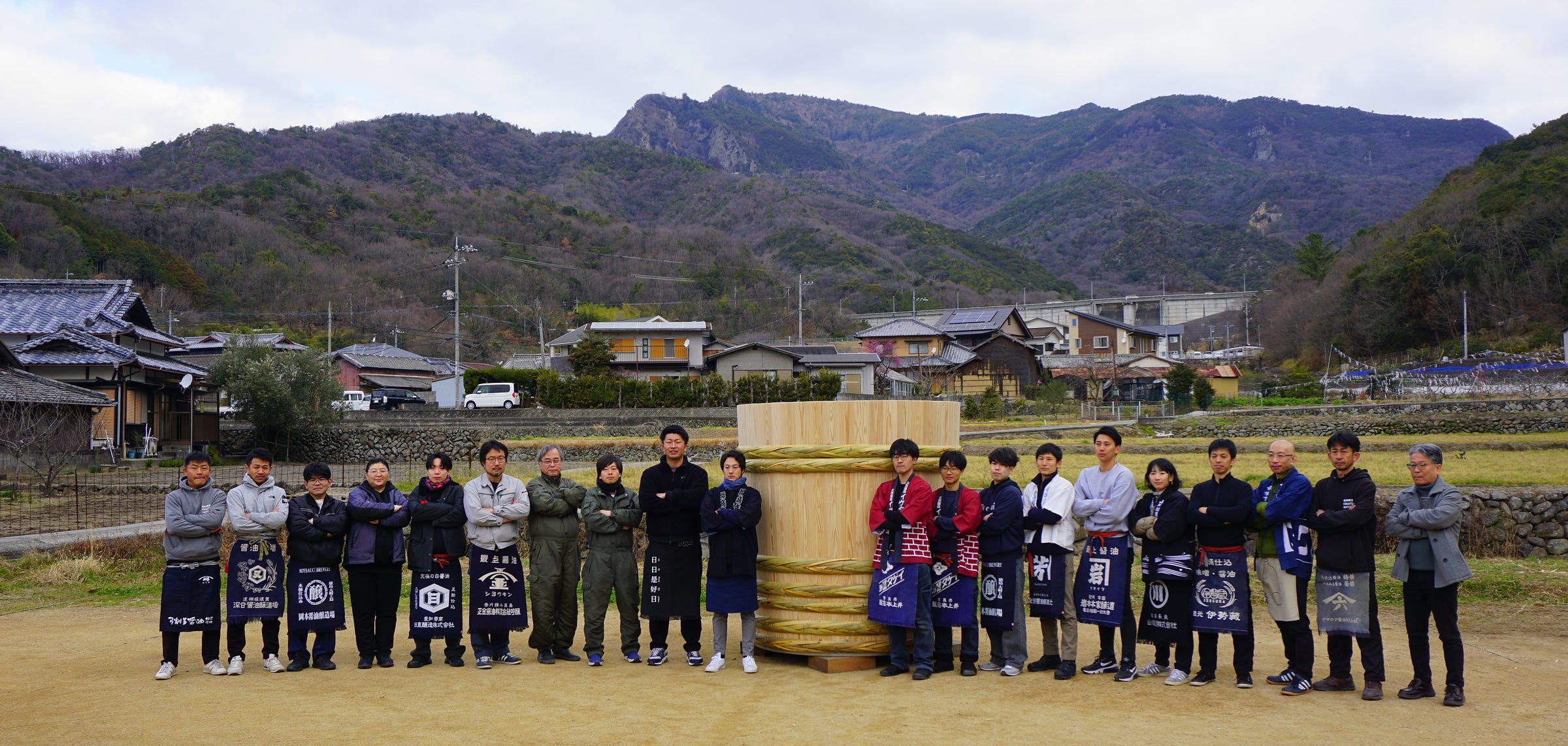
What a great series, Gianni-san, I hope to read more about your travels in Japan.